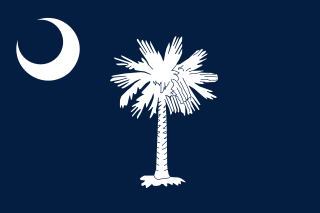
Edgefield County is a county located on the western border of the U.S. state of South Carolina. As of the 2010 census, its population was 26,985. Its county seat is Edgefield.
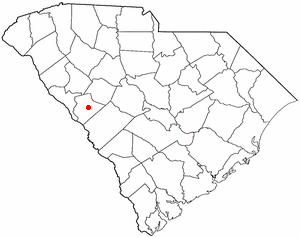
Edgefield is a town in Edgefield County, South Carolina, United States. The population was 4,750 at the 2010 census. It is the county seat of Edgefield County.
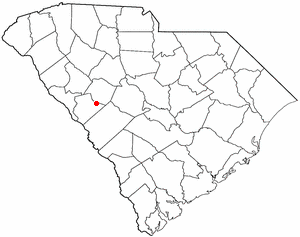
Johnston is a town in Edgefield County, South Carolina, United States. The population was 2,362 at the 2010 census. It is part of the Augusta, Georgia, metropolitan area. The town's official welcome sign states that it is "Peach Capital of the World".

The ghost town of Hamburg, South Carolina, was once a thriving upriver market located in Edgefield District of the Piedmont. It was founded by Henry Shultz in 1821, across the Savannah River from Augusta, Georgia, in direct competition with that city. In its heyday, 60,000 bales of cotton worth $2,000,000 were brought by wagon to Hamburg each year. This cotton continued by pole boat or steam boat to the ports of Charleston or Savannah for subsequent shipment to manufacturers in New England or Europe. Hamburg lost business after Augusta completed its canal in 1848.
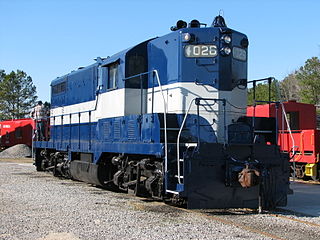
The Georgia Railroad and Banking Company also seen as "GARR", was a historic railroad and banking company that operated in the U.S. state of Georgia. In 1967 it reported 833 million revenue-ton-miles of freight and 3 million passenger-miles; at the end of the year it operated 331 miles (533 km) of road and 510 miles (820 km) of track.

The Hamburg massacre was a key event in South Carolina during July 1876, leading up to the last election season of the Reconstruction Era. It was the first of a series of civil disturbances, many of which Democrats planned in the majority-black/Republican Edgefield District, to disrupt Republican meetings and suppress black voting through actual and threatened violence.
The Augusta and Knoxville Railroad (A&K) was a railroad company that operated on 66 miles (106 km) of track between Augusta, Georgia, and Greenwood, South Carolina, from 1882 to 1886. It was merged with three other companies to form the Port Royal and Western Carolina Railway, which was reorganized in 1896 as the Charleston and Western Carolina Railway.
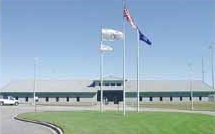
The Federal Correctional Institution, Edgefield is a medium-security United States federal prison for male inmates in South Carolina. It is operated by the Federal Bureau of Prisons, a division of the United States Department of Justice. The facility also has an adjacent satellite prison camp for minimum-security male offenders which houses between 500 and 549 inmates.

The Augusta metropolitan area is a metropolitan area in the U.S. states of Georgia and South Carolina centered on the principal city of Augusta. The U.S. Office of Management and Budget, Census Bureau and other agencies define Augusta's Metropolitan Statistical Area, the Augusta-Richmond County, GA-SC Metropolitan Statistical Area, as comprising Richmond, Burke, Columbia, Lincoln, and McDuffie Counties in Georgia and Aiken and Edgefield Counties in South Carolina. As of the 2010 Census, the area had a population of 556,877, though a 2014 estimate of it was at 583,632.
The Edgefiled Branch Railroad was a South Carolina railroad that existed immediately after the Reconstruction Era of the United States.
The Edgefield, Trenton and Aiken Railroad was a railroad that served South Carolina immediately after the end of the Reconstruction Era of the United States.
The Georgia and Carolina Midland Railroad was a Southeastern railroad company created in the late 19th century by the merger of two existing southern carriers.
The Belton, Williamston and Easley Railroad was a Carolinian railroad company, chartered shortly after the end of the Reconstruction Era of the United States.
The Augusta Northern Railway was a shortline railroad that served western South Carolina in the first half of the 20th century.
The Atlantic and Northwestern Railroad was a railroad that served the Upstate region in the period after Reconstruction.
The Union, Gaffney City and Rutherfordton Railroad was a railroad chartered by the South Carolina General Assembly shortly after the end of Reconstruction.
The Carolina and Cumberland Gap Railway was a railroad in the Southeastern United States that existed in the late 19th century.
The Newberry, Whitmire and Augusta Railroad was a South Carolina railroad company founded in the early part of the 20th century.
Fox Creek High School is a public college-preparatory charter school within the South Carolina Public Charter School District, located near North Augusta, South Carolina, United States. It serves students in grades 9–12 in Aiken and Edgefield counties.
